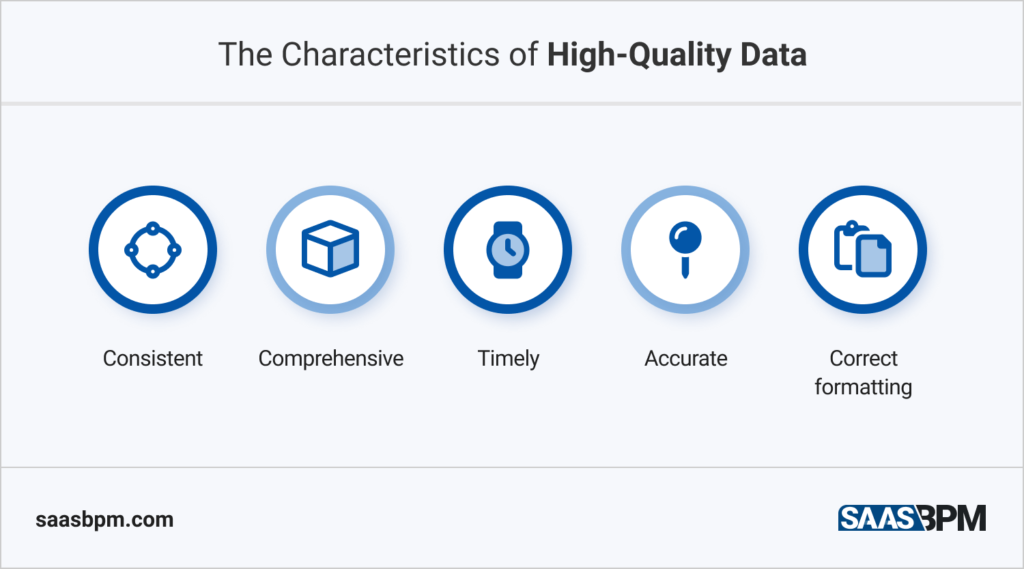Digital marketing strategies are continuously advancing every day. Collecting the right data plays a huge role in B2B marketing online, and a lot of companies have been realizing this lately. Poor-quality data can lead to bad decision-making, overspending, loss of revenue, inaccurate analysis, and less than desirable customer relations.

In this article, we will talk about what collecting high-quality data means to B2B companies, how it can impact your business, and how to use it to improve your B2B marketing stats.
Defining Data Quality
Data quality refers to the status that a given dataset is classified in. If the data is deemed as low-quality, it will negatively affect the organization and everything that surrounds it. For example, if the data were collected from sources that are not credible, then this is reckoned to be inaccurate. At the same time, if the data was tracked using the wrong tools and tactics, then it cannot be considered high-quality data.
Implementing quality data analysis allows organizations to come up with informed decisions regarding the company’s overall success. So, how do you know if the data that you have on hand is accurate and high-quality? Here are some steps to find out:
- Consistent. Your data should be consistent across all platforms. If you use different tools to keep your data in place, then you’d want to make sure that each report or spreadsheet is showing the right numbers. Consider using a BPM tool to keep all of your data in one place to avoid confusion and for better visibility.
- Comprehensive. The data must be complete and precise for it to work. For example, you are trying to collect information for your lead generation. The data must contain everything including your customer’s complete name, address, contact number, email address, and more. Creating a buyer persona will help you determine such things.
- Timely. Numbers can change over time, and it is crucial to check the timeliness of your data every once in a while.
- Accurate. The figures that you have collected must closely represent the results that you have in mind. It must come from reliable sources – ones that you know you can fact-check for better accuracy.
- Correct formatting. Data entry formats must be consistent across all channels. Human error can sometimes cause gaps and mistakes within platforms, and using automation software can help eliminate this problem.

Now that we have discussed what quality data means and how it can affect your B2B marketing plan, let’s delve into how you can collect accurate figures to leverage your tactics.
Start With Your Employees
Collecting high-quality statistics usually depends on how skilled your employees are. Make sure that they have the right skillset to garner the right numbers and store them correctly.
Furthermore, as a leader, you should make it a point to check the data that they have collected regularly. Review their work or pass it on to their superiors and ask for feedback. For starters, you can listen to the calls that your marketing team makes or read the emails that they send to see if they are collecting the right information from your customers. Make a list of the mistakes and gaps that you are noticing and give them feedback every once in a while.
You can also provide training and regular one-on-one sessions to drive improvement on how they collect data from consumers and across the internet.
See How Data Influences Your Business Decisions
To further understand how to improve your data quality, you must first get into the root of why you are collecting such figures in the first place. See how these numbers are linked to your data assets, KPIs, and overall business processes. Create a list of the data collection issues that your organization is facing and how it is directly impacting your results.

Once you have figured out your pain points and why your business is not doing as well as you’ve pictured it out to be, you can start discerning the main root of the problem. This will help you create a better plan that will help you achieve your long-term business goals.
Implement Data Profiling
Consider assigning a team to work on data quality issues, cleansing, and delving deep into the problems that you are encountering. Equip them with the tools that are needed to understand the linkage between these errors and how to improve quality data analysis. The following pointers further explain what data profiling is:
- Recognizing recurring data patterns and collecting different data types.
- Regularly performing data analysis and the risks that come with it.
- Using keywords, categories, and descriptions to tag the data.
- Having clear descriptive such as sum, min, max, and count.
- Identifying key distribution factors such as key candidates, functional dependencies, and doing a deep dive into inter-table analysis.
Reviewing your data and getting down to the source will help leverage your data profiling activities. Understanding the overall structure and using the right software will help you get a clearer picture of the statistics that you have collected.
Use a Centralized Software

A cluttered and unorganized system will get you nowhere when it comes to quality data analysis. If you are using numerous spreadsheets and reporting channels for your figures, then chances are you will mess the data at one point. To make everything easier for everyone involved in the process, it is better to use centralized automation software that everyone in the team can access.
To start, make sure to pull your data out from reliable sources. Double-check the statistics and have the other leaders take a look at them. Lastly, collect all of the information and input it into the system that you currently have. This way, the whole team can see the metrics in one place, which makes aligning the data easier and faster.
Building a funnel or a process that one can strictly follow will help minimize errors along the way.
The Bottom Line
Collecting high-quality data shouldn’t put a strain on your processes. It can be done smoothly, as long as you have the right tools and your employees completely understand what needs to be done. Remember: your business’ success lies within the data that you collect. Whether the statistics come from your customers, the internet, or other sources, it all comes down to the accuracy of the information that you have on hand and how you are deciding to use it.

